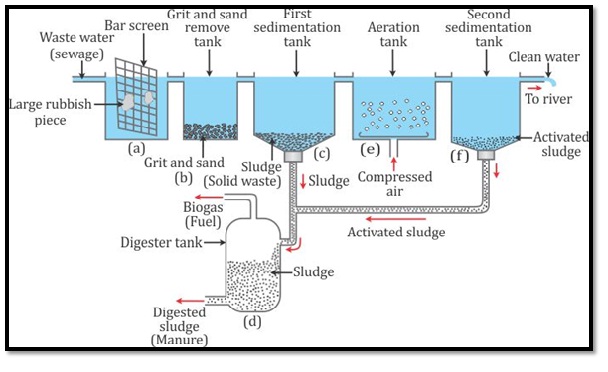CBSE Class 7 Answered
SIR , PLEASE EXPLAIN WASTEWATER TREATMENT PLANT PROCESS TO CLEAN WATER IN BRIEF .
Asked by Rupali | 08 Sep, 2015, 01:30: PM
Waste water treatment includes physical, chemical as well as biological processes.
The steps involved in the treatment are as follows:
- Screening - Waste water is passed through bar screens. Large and easily visible objects such as sticks, cans, plastic packets and napkins are removed.
- Grit and sand removal - Water then enters a grit and sand removal tank. Water is passed slowly to allow sand, grit and pebbles to settle down.
- Water is allowed to settle in a large tank which slopes towards the middle. Solids (e.g. faeces) settle at the bottom and are removed with a scraper. This is sludge. A skimmer removes the floatable solids (e.g. oil and grease). Water so cleared is called clarified water.

- The sludge is then transferred to a separate tank where anaerobic bacteria decompose it. The biogas produced in the process can be used to produce electricity.
- Aeration: Anaerobic bacteria are allowed to grow by pumping in air into clarified water. Bacteria consume the unwanted matter still present in the clarified water.
- From the aeration tank, treated water is sent to another sedimentation tank, where, after several hours, the suspended microbes settle down as activated sludge and the water from the top is removed. As this activated sludge is about 97% water, sand drying beds or machines are used to remove water. The dried sludge is now used as manure, thereby returning the organic matter and nutrients to the soil.
- The treated water has a very low level of organic and suspended matter and is hence discharged into seas, rivers or into the ground.
- Sometimes, chemicals such as chlorine and ozone are used to disinfect water before releasing it into the distribution system.
Answered by Hemangi Binny | 08 Sep, 2015, 02:30: PM
Concept Videos
CBSE 7 - Science
Asked by jasvirbhaini8872 | 12 Jan, 2021, 02:51: PM
CBSE 7 - Science
Asked by dediramshiya | 20 Feb, 2020, 11:54: PM
CBSE 7 - Science
Asked by deeparathee35 | 18 Feb, 2020, 08:21: PM
CBSE 7 - Science
Asked by geeta2606 | 21 May, 2019, 12:23: PM
CBSE 7 - Science
Asked by gspublicschool | 12 Mar, 2019, 08:35: AM
CBSE 7 - Science
Asked by gspublicschool | 11 Mar, 2019, 08:55: AM
CBSE 7 - Science
Asked by gspublicschool | 06 Mar, 2019, 10:29: AM
CBSE 7 - Science
Asked by gspublicschool | 05 Mar, 2019, 12:56: PM
CBSE 7 - Science
Asked by gspublicschool | 05 Mar, 2019, 12:52: PM
CBSE 7 - Science
Asked by gspublicschool | 01 Mar, 2019, 10:13: AM


